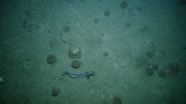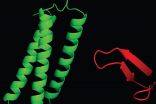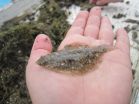(Press-News.org) Researchers reporting in the Cell Press journal Current Biology on August 27 have evidence in support of a clearly defined depth limit for deep-sea fishing in Europe. The findings come just as the European Union considers controversial new legislation to manage deep-sea fisheries, including a ban on trawling below 600 meters.
"The most notable thing to consider about our findings is that the trend in catch composition over the depth range of 600 to 800 meters shows that collateral ecological impacts are significantly increasing while the commercial gain per unit effort is decreasing," says Joanne Clarke of the University of Glasgow.
In other words, "going deeper causes greater and greater damage for a reducing benefit to fishermen."
Studies have already shown that deep-sea fish species are more vulnerable, due to the fact that individuals tend to live for a long time while having relatively few offspring in comparison to shallow-water species. Evidence has also shown that deep-sea bottom trawling has taken its toll, with implications for the deep-sea ecosystem and for the climate. Deep-sea fish sequester large amounts of carbon per year.
The question, Clarke says, was: "Why a depth limit, and what depth?"
Study authors David Bailey of the University of Glasgow and Francis Neat of Marine Scotland Science came up with a way to find out by looking at changes in catch composition trends with depth. The researchers collected data from trawl surveys between the depths of 240 and 1,500 meters in the northeast Atlantic. Those surveys used different gear types at various locations between 1978 and 2013.
An analysis of those data revealed a clear transition in catches at depths of 600 to 800 meters, including a significant increase in biodiversity, the ratio of discarded to commercial biomass, and the ratio of sharks and rays to commercial biomass. As the ecological impacts increased, the commercial value per unit of effort decreased.
"Depth limitations are often labelled as a 'blanket' measure, unsophisticated and poorly thought out," Clarke says. "In this case, however, it appears that there would be some very specific conservation benefits to a depth limit at around 600 meters."
The discovery that their evidence backed the latest depth-limit proposal came as a surprise to the researchers.
"We had no prior reason to expect that our findings would suggest that this was in fact an appropriate depth," Clarke says. "We went into this analysis purely to test whether any depth appeared particularly suitable for a depth limit, but with no expectation that this would be the case."
European Council discussions on the matter are expected to begin again in September and, while there are many other factors at play, the researchers say they are "very confident that the work will be brought to the attention of the relevant people and at a critical time."
INFORMATION:
This study was supported by funding from the EU's INTERREG IVA Programme managed by the Special EU Programmes Body. The early surveys by SAMS and IOS were supported directly by the Natural Environment Research Council and analysis is contributed to the EU-HERMES program. Later surveys were funded through the Natural Environment Research Council and Marine Scotland Science surveys were funded by the Scottish Government under projects ECOSDEEP, OFFCON, and MOREDEEP.
Current Biology, Clarke et al.: "A Scientific Basis for Regulating Deep-Sea Fishing by Depth" http://dx.doi.org/10.1016/j.cub.2015.07.070
Current Biology, published by Cell Press, is a bimonthly journal that features papers across all areas of biology. Current Biology strives to foster communication across fields of biology, both by publishing important findings of general interest and through highly accessible front matter for non-specialists. For more information please visit http://www.cell.com/current-biology. To receive media alerts for Current Biology or other Cell Press journals, contact press@cell.com.
Isaac Newton was a classic neurotic. He was a brooder and a worrier, prone to dwelling on the scientific problems before him as well as his childhood sins. But Newton also had creative breakthroughs--thoughts on physics so profound that they are still part of a standard science education.
In a Trends in Cognitive Sciences Opinion paper published August 27, psychologists present a new theory for why neurotic unhappiness and creativity go hand-in-hand. The authors argue that the part of the brain responsible for self-generated thought is highly active in neuroticism, which ...
Researchers at the Virginia Bioinformatics Institute at Virginia Tech have uncovered key cellular functions that help regulate inflammation -- a discovery that could have important implications for the treatment of allergies, heart disease, and certain forms of cancer.
The discovery, to be published in the Oct. 6 issue of the journal Structure, explains how two particular proteins, Tollip and Tom1, work together to contribute to the turnover of cell-surface receptor proteins that trigger inflammation.
"The inflammatory response can be a double-edged sword," said Daniel ...
Mobility between different physical environments in the cell nucleus regulates the daily oscillations in the activity of genes that are controlled by the internal biological clock, according to a study that is published in the journal Molecular Cell. Eventually, these findings may lead to novel therapeutic strategies for the treatment of diseases linked with disrupted circadian rhythm.
So called clock-controlled - or circadian - genes are part of the internal biological clock, allowing humans and other light-sensitive organisms to adjust their daily activity to the cycle ...
Cold Spring Harbor, NY - When a large combat unit, widely dispersed in dense jungle, goes to battle, no single soldier knows precisely how his actions are affecting the unit's success or failure. But in modern armies, every soldier is connected via an audio link that can instantly receive broadcasts - reporting both positive and negative surprises - based on new intelligence. The real-time broadcasts enable dispersed troops to learn from these reports and can be critical since no solider has an overview of the entire unit's situation.
Similarly, as neuroscientists at Cold ...
LA JOLLA--Every organism--from a seedling to a president--must protect its DNA at all costs, but precisely how a cell distinguishes between damage to its own DNA and the foreign DNA of an invading virus has remained a mystery.
Now, scientists at the Salk Institute have discovered critical details of how a cell's response system tells the difference between these two perpetual threats. The discovery could help in the development of new cancer-selective viral therapies and may help explain why aging and certain diseases seem to open the door to viral infections.
"Our ...
Working with human cancer cell lines and mice, researchers at the Johns Hopkins Kimmel Cancer Center and elsewhere have found a way to trigger a type of immune system "virus alert" that may one day boost cancer patients' response to immunotherapy drugs. An increasingly promising focus of cancer research, the drugs are designed to disarm cancer cells' ability to avoid detection and destruction by the immune system.
In a report on the work published in the Aug. 27 issue of Cell, the Johns Hopkins-led research team says it has found a core group of genes related to both ...
Understanding exactly what is taking place inside a single cell is no easy task. For DNA, amplification techniques are available to make the task possible, but for other substances such as proteins and small molecules, scientists generally have to rely on statistics generated from many different cells measured together. Unfortunately, this means they cannot look at what is happening in each individual cell.
Now, thanks to seven years of work done at the RIKEN Quantitative Biology Center and Hiroshima University, scientists can take a peek into a single plant cell and--within ...
In experiments with mouse tissue, UC San Francisco researchers have discovered that the adaptive immune system, generally associated with fighting bacterial and viral infections, plays an active role in guiding the normal development of mammary glands, the only organs--in female humans as well as mice--that develop predominately after birth, beginning at puberty.
The scientists say the findings have implications not only for understanding normal organ development, but also for cancer and tissue-regeneration research, as well as in the highly active field of cancer immunotherapy, ...
Philadelphia, PA, Aug 27, 2015 - Having twins accounts for only 1.5% of all births but 25% of preterm births, the leading cause of infant mortality worldwide. Successful strategies for reducing singleton preterm births include prophylactic use of progesterone and cervical cerclage in patients with a prior history of preterm birth. To investigate whether the use of a cervical pessary might reduce premature births of twins, an international team of researchers conducted a large, multicenter, international randomized clinical trial (RCT) of approximately 1200 twin pregnancies. ...
DURHAM, N.H. - Researchers at the University of New Hampshire are turning to an unusual source --otoliths, the inner ear bones of fish -- to identify the nursery grounds of winter flounder, the protected estuaries where the potato chip-sized juveniles grow to adolesence. The research, recently published in the journal Transactions of the American Fisheries Society, could aid the effort to restore plummeting winter flounder populations along the East Coast of the U.S.
In addition to showing the age of a fish, much like the rings in the cross-section of a tree, otoliths ...





